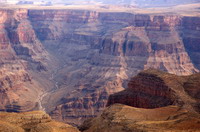Login form
Grand Canyon

The Grand Canyon is a place of extraordinary beauty. This giant gash in the plateau of northern Arizona drops down almost a mile. Standing on the plateau, you’ll see spectacular rock formations in a variety of colors—orange, purple, red, pink, and green. The colors change as the Sun moves through the sky during the day. There are many breathtaking views of these colorful rocks from trails into the canyon and from overlooks on the rim of the canyon.
THE AMAZING COLORADO RIVER
At the bottom of the canyon, you’ll see a thin, blue ribbon of water. This ribbon is the Colorado River.
The Colorado created the Grand Canyon. It probably took the Colorado River about 6 million years to carve the canyon. The Colorado is still at work.
The Colorado has dug valleys and carved beautiful ridges, hills, and other rock formations. It has had help from ice and other forces. As rainwater freezes in cracks in rocks, it expands and pushes the rock apart. Eventually, pieces of rock break off and fall into the canyon.
VISITING THE GRAND CANYON
The Grand Canyon National Park contains an impressive stretch of the canyon. About 4 million people visit the park every year. Most visitors come to the south rim of the Grand Canyon. The south rim is open year-round. The north rim of the canyon is higher and colder than the south rim. The north rim is closed from October to May because of snow.
Many people hike from the rim to the bottom of the Grand Canyon and back. From the south rim, it’s a long, difficult hike that takes a day each way. It’s even longer from the north rim. Hikers can camp out or stay overnight at a ranch at the bottom. You can even ride a mule to the bottom of the canyon and back.
Some people travel through the Grand Canyon by raft down the Colorado River. This trip takes several days.
Many kinds of animals live in the Grand Canyon. You might see a coyote or bobcat prowling on a distant ledge, lizards sunning themselves on nearby rocks, or mountain bluebirds flitting through the air. You will certainly see squirrels. In addition, close to 2,500 kinds of plants grow in the canyon.
HISTORY
Native Americans have lived in the Grand Canyon for thousands of years. Ancient cliff dwellings are still visible on the canyon walls. The Havasupai Indian Reservation and Hualapai Indian Reservation are located along the Colorado River in the Grand Canyon.
Europeans first saw the canyon in 1540. They traveled from Mexico with Spanish explorer Francisco Vásquez de Coronado. Because of its rugged and remote location, The canyon remained largely unexplored for more than 300 years. In 1869, American explorer John Wesley Powell and ten companions made the dangerous journey down the Colorado River in four small wooden boats.
The U.S. Congress established the Grand Canyon National Park in 1919. In 1979, the canyon was named a World Heritage Site.
Source: Microsoft ® Encarta

